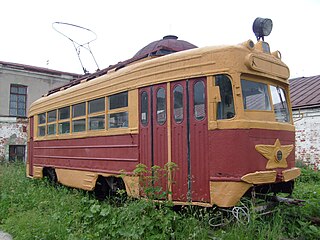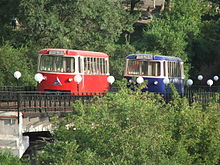
A trolleybus is an electric bus that draws power from dual overhead wires using spring-loaded trolley poles. Two wires, and two trolley poles, are required to complete the electrical circuit. This differs from a tram or streetcar, which normally uses the track as the return path, needing only one wire and one pole. They are also distinct from other kinds of electric buses, which usually rely on batteries. Power is most commonly supplied as 600-volt direct current, but there are exceptions.

The LM-49 is the Soviet motor four-axle tramcar. The first prototype of this vehicle was built in 1949 at the Leningrad Wagon Repair Plant. "LM" means Leningrad Motor tramcar. These tramcars were utilized in Leningrad itself and some other Soviet cities such as Minsk, Gorky], Novokuznetsk and Magnitogorsk. VARZ produced in total 287 LM-49s for Leningrad and 113 for other cities.

MTV-82 is a Soviet four-axle tramcar.

The ZiU-5 is a Soviet trolleybus model that was built by the Uritsky factory. The ZiU acronym stands for Zavod imeni Uritskogo, which translates as Plant named after Uritskiy. This model of city trolleybus was in mass production from 1959 to 1972. The total number of ZiU-5s produced exceeded 14,500 vehicles. This allowed the ZiU-5 to become dominant model of trolleybus in Soviet towns and cities of that time. The last vehicles were withdrawn from active service in the mid-1980s. The small number of surviving vehicles are kept now for museum purposes.

Trams in Saint Petersburg are a major mode of public transit in the city of Saint Petersburg, Russia. Saint Petersburg once had the second-largest tram network in the world, consisting of about 340 kilometres (210 mi) of unduplicated track in the late 1980s. However, since 1995 the tramway network has declined sharply in size as major portions of track were removed, particularly in the city centre. Saint Petersburg lost its record to Melbourne, Australia. While it still had 285 kilometres (177 mi) of length in 2002, by early 2007 the tram network's had declined to just over 220 kilometres (140 mi), and by the 2010s operated on just 205.5 kilometres (127.7 mi) of network.

ZiU-9, or ZIU-9 is a Soviet trolleybus. Other names for the ZiU-9 are ZiU-682 and HTI-682. The ZiU acronym stands for Zavod imeni Uritskogo, which is a plant named after Moisei Uritsky, the Russian revolutionary. Before 1996 this acronym was also a trademark of the vehicle manufacturer Trolza. The ZiU-9 was first built in 1966, although it was only put into mass production in 1972 and it was still assembled along with other more advanced trolleybus vehicles in the Trolza factory until 2015. The total number of produced ZiU-9s exceeds 42,000 vehicles making it the most produced trolleybus in the world. In addition, many copies of ZiU-9 were made in other factories of the former Soviet bloc.

The Kyiv Tram is a tram network which serves the Ukrainian capital Kyiv. The system was the first electric tramway in the former Russian Empire and the fourth one in Europe after the Berlin and the Budapest and Prague tramways. The Kyiv Tram system currently consists of 139.9 km (86.9 mi) of track, including 14 km (8.7 mi) two Rapid Tram lines, served by 21 routes with the use of 523 tram cars. However, the system is being neglected, the serviced track length is decreasing at a fast rate and is replaced by buses and trolleybuses.

LVS-86 is a model of tramcar developed at the Leningrad Tram Manufacturing Plant in the former Soviet Union. LVS stands for "Leningrad-made articulated tram" in Russian, and 86 refers to the model year. The design was based on the LVS-80 tramcar. 473 LVS-86s were built from 1987 until 1997. LVS-86s currently run in Saint Petersburg and formerly in Arkhangelsk. Tram operation in Arkhangelsk ceased in July 2004.

LVS-97 (71-147) is a Russian-made six axle tram. LVS denotes «Ленинградский Вагон Сочленёный» which is an articulated tramcar, made in St. Petersburg. It was produced at the Petersburg Tram Mechanical Factory from 1997 through to 2004.

KTM-1 is a Soviet-made two-axle tram with a metal body. KTP-1 is a two-axle trailer car to intended to work under KTM-1 traction. It was the first Soviet-made tram to be originally single ended, as well as designated to work on looped lines. It was the first Soviet-made tram with wide four-segment folding doors and bigger passenger storage spaces. Doors were driven pneumatically.

Rīgas Satiksme is a municipally-owned public transportation and infrastructure company serving Riga, Latvia and the surrounding areas. It was founded on 20 February 2003 as an umbrella organisation for the respective operators of trams, buses and trolleybuses in the city of Riga. Two years later, the separate operators of the different modes of public transport were merged and re-branded to its current name.
Petersburg Tram Mechanical Factory (PTMF) was one of the leading manufacturers of tramcars in Russia and the CIS-countries located in Saint Petersburg. As the only tram manufacturing plant in Russia for several decades, it was the sole supplier of rolling stock for the tram system in St. Petersburg.

The first trolleybus vehicle in Russia was built in Saint Petersburg in 1902 at Frese machine-building factory. It utilised a carriage-type current collector like the early von Siemens prototypes. There was no attempt to organize passenger or cargo services at this time.

The Kolomna Locomotive Works is a major producer of railroad locomotives as well as locomotive and marine diesel engines in Russia. The plant started production in 1869 with a freight steam locomotive, one of the first in Russia. In the Czarist period before the Russian Revolution, Kolomna was one of a very few producers in Russia. During this period 139 types of steam locomotives were designed. The company is now (2015) a part of Transmashholding.
This is an overview of rolling stock manufacturers of Russia, which includes historical and current information.

The Tallinn tram network is the only tram network in Estonia. Together with the four-route trolleybus network (et), the four tram lines, with a total length of 19.7 km arranged in a roughly cross-shaped layout, provide a backbone for the public transport network in the Estonian capital. All the routes meet up at Hobujaama in the city centre. Trams are unidirectional, one-sided and single-person operated, and much of the network runs on segregated track.

PC Transport systems LLC is a Russian company specializing in the production of urban electric vehicles: trams, trolleybuses and electric buses.

The KTM-5, later known as the 71-605, is a Soviet tram model manufactured by UKVZ. First introduced in 1963, the KTM-5 was mass-produced between 1969 and 1992, with a total of 14,991 tramcars being made. KTM-5 trams were built exclusively for the Soviet Union, and therefore are currently only operating in post-Soviet states. Despite this, the KTM-5 is the world's most produced tram.




















